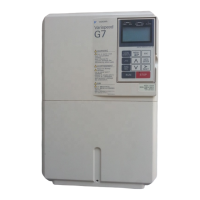What causes speed deviation (dEV) in YASKAWA CIMR-SSA Inverter?
- MMichael MooreSep 10, 2025
If the YASKAWA Inverter indicates a speed deviation (dEV), check the load.

What causes speed deviation (dEV) in YASKAWA CIMR-SSA Inverter?
If the YASKAWA Inverter indicates a speed deviation (dEV), check the load.
What to do if YASKAWA Inverter displays overvoltage (OV)?
If the YASKAWA Inverter is showing an overvoltage (OV) error because the main circuit DC voltage has exceeded the OV level, try extending the deceleration time. If the issue persists, consider adding a braking circuit.
How to fix YASKAWA CIMR-SSA overload (OL2)?
If your YASKAWA Inverter displays an inverter overload (OL2) message, it means the inverter output has exceeded the overload level. To resolve this, try reducing the load. Additionally, consider extending the acceleration time.
Why is my YASKAWA Inverter showing an overheat alarm (OH)?
If the YASKAWA Inverter is overheating, indicated by an (OH) alarm, the transistor heatsink temperature has likely exceeded the allowable value (95°C). You should check the heatsink and ambient temperature. Also, inspect the filter and the fan for any issues.
What causes ground fault (GF) on YASKAWA Inverter?
If the YASKAWA Inverter indicates a ground fault (GF), and the inverter output grounding current has exceeded 50% of the inverter's rated current, check the motor insulation for any signs of deterioration. Also, verify that the connection between the inverter and the motor is not damaged.
What to do if YASKAWA Inverter shows load open-phase (LF)?
If the YASKAWA Inverter displays a load open-phase (LF) error, and the inverter output has an open phase, start by checking the output wiring. Also, check the motor impedance and re-tighten the input terminal screws.
How to troubleshoot transmission fault with transmission option (bUS) on YASKAWA CIMR-SSA Inverter?
If the YASKAWA Inverter shows a transmission fault with transmission option (bUS), check the transmission devices and the transmission signals.
What does digital operator fault (OPr) mean on YASKAWA Inverter?
If the YASKAWA Inverter shows a 'Digital operator fault (OPr)' because the digital operator was disconnected during operation by run command from the digital operator, check the wiring cable and the digital operator connection. Also, replace the control card.
How to fix phase Z pulse fault (ZdEV) on YASKAWA CIMR-SSA Inverter?
If the YASKAWA Inverter displays a 'Phase Z pulse fault (ZdEV)' due to excessive speed deviation, check the PG wiring cable and connector. Also, readjust the zero-pulse.
What does control circuit fault 1 (CPF00) mean on YASKAWA CIMR-SSA?
If the YASKAWA Inverter displays a 'Control circuit fault 1 (CPF00) (Digital operator transmission fault)' error, where transmission between the inverter and digital operator cannot be established 5 seconds after supplying power, insert the digital operator connector again. Also, check the control circuit wiring and replace the control card.
| Series | CIMR-SSA |
|---|---|
| Category | Inverter |
| Frequency Range | 0.1 - 400 Hz |
| Overload Capacity | 150% for 60 seconds |
| Operating Temperature | -10°C to +50°C (14°F to 122°F) |
| Cooling Method | Fan Cooled |
| Output Voltage | 0 to Input Voltage |
| Control Method | V/f Control, Vector Control |
| Protection Functions | Overcurrent, Overvoltage, Undervoltage |
| Protection Features | Short Circuit Protection |
| Communication | Modbus RTU |
| Enclosure | IP20 |
| Storage Temperature | -20°C to +60°C (-4°F to 140°F) |
| Humidity | 95% RH or less (non-condensing) |
| Enclosure Rating | IP20 |
| Input Voltage | 200V, 400V |
| Horsepower Range | 0.5-300 HP |
General safety and handling guidelines for the manual and product.
Explanation of WARNING and CAUTION symbols used for safety instructions.
Procedures for checking the inverter upon delivery to the user.
Identification of major external components of the VS-686SS5 inverter.
Instructions for removing and installing the digital operator unit.
Steps for removing and replacing the inverter's front cover.
Recommendations for selecting a suitable installation location for the inverter.
Required space around the inverter for effective cooling and ventilation.
Standard connection diagram for the VS-686SS5 with peripheral units.
Detailed wiring diagram for main and control circuits of the inverter.
Safety precautions and procedures for wiring the main circuit of the inverter.
Wiring methods for contact output and open collector output.
Final checks after installation and wiring to ensure correctness.
Items to check before performing a test run of the inverter.
Procedure for setting the input line voltage using jumpers.
Steps for performing a test run and verifying inverter operation.
Procedures for configuring control methods and motor parameters.
Examples of basic inverter operation modes like jog and manual control.
Explanation of keys and indicators on the digital operator.
Overview of the three operating modes of the digital operator.
How to use the drive mode for monitoring and operation.
Procedures for initializing settings before using the inverter.
How to set and read constants in program mode.
How to view and modify constants changed from factory settings.
Essential safety warnings and cautions before performing maintenance.
Recommended schedule and checks for routine maintenance.
Guidelines for periodic replacement of key inverter components.
Identification and resolution of inverter fault displays.
Troubleshooting guide for common motor operational faults.
Technical specifications for the variable torque series of inverters.
Technical specifications for the constant torque series of inverters.
Physical dimensions and mounting hole details for different inverter models.
Wiring diagrams for connecting braking resistor units.
Wiring diagrams for braking units and resistor units.
Connection diagrams for multiple braking units in parallel.
Wiring diagrams for output circuits with contact and open collector outputs.
List of monitorable parameters and their availability by control method.
Comprehensive list of inverter constants, their initial, and user settings.
Table mapping motor output and speed to selection codes.
Table of error codes and descriptions during PG zero-pulse adjustment.
Troubleshooting for Phase-Z pulse errors and reverse detection.












